What party or candidate spent the most, who shares ads with mistakes, and what Ukrainian party paid for Facebook ads in RUB.
In the beginning of autumn, most politicians and political forces planning to run for local elections have become more active in social media. OPORA has explored activity levels of political parties on Facebook in June to August, 2020. The analysis of expenses incurred by political forces in the first half of September shows that some of them spent for advertising in social media more than over the summer.
As to Ukrainian segment of Facebook, OPORA experts identified 2,210 pages that were using political ads in the first half of September. Most of them spent under USD 100. That is why we focused on those who spent more. There are 415 pages like that. Mostly, they are the pages of political parties, candidates for local elections, party members and media pages. In total, they posted 19,429 posts and spent almost USD 345,000 for promotion (UAH 9.7 mln). Daily costs for political ads were indicative, too. On average, almost a thousand of pages spent daily USD 4,370 for political ads.
Most of the money account for the party pages. In two weeks, a hundred and fifty pages of various political forces spent on Facebook ads over USD 186,000. Next follow the parties that spent the most:
|
Party costs for political ads |
|||
|
Party |
Costs, USD |
Number of ads |
Number of pages |
|
“FOR THE FUTURE” political party |
60,794 |
2,254 |
30 |
|
Servant of the People |
36,242 |
1,424 |
20 |
|
Palchevskyi Victory |
14,852 |
163 |
3 |
|
Proposition |
11,723 |
606 |
15 |
|
European Solidarity |
11,628 |
146 |
13 |
|
Nash Kray |
10,700 |
1,443 |
5 |
|
UDAR of Vitaliy Klychko |
6,711 |
195 |
4 |
|
“Oppositional Platform – For Life” |
6,363 |
243 |
3 |
|
Bereza EcoParty |
5,835 |
164 |
1 |
|
Udovichenko Team – Ridne Misto |
3,212 |
123 |
1 |
“For the Future” ads were posted by thirty pages (central Політична партія «ЗА МАЙБУТНЄ» [lit. – Political Party FOR THE FUTURE] and regional Рівненщина ЗА Майбутнє [lit. – Rivne region For the Future], «За МАЙБУТНЄ» Хмельниччина [lit. – For the Future Khmelnytskyi region], a.o. For the 2,254 ads, the party spent USD 60,800 (over UAH 1.7 mln.).Over the three previous months, “For the Future” spent less – as little as USD 50,000. The party is trying to show their ads to citizens in all territories. 11% of ads are targeting Kyiv Oblast, 8% — at Zaporizhzhia Oblast; the number in other regions is much lower — 1.3% in Mykolayiv Oblast, 2% in the city Kyiv. 65% of the viewers targeted with the “For the Future” ads are women.

fb.oporaua.org
The advertising posts from the “For the Future” invite new followers for the pages, introduce local teams to supporters, and tell about the so called “Open Supporters’ Fora”. These are regional conventions where the party introduces their program and potential candidates to local councils.
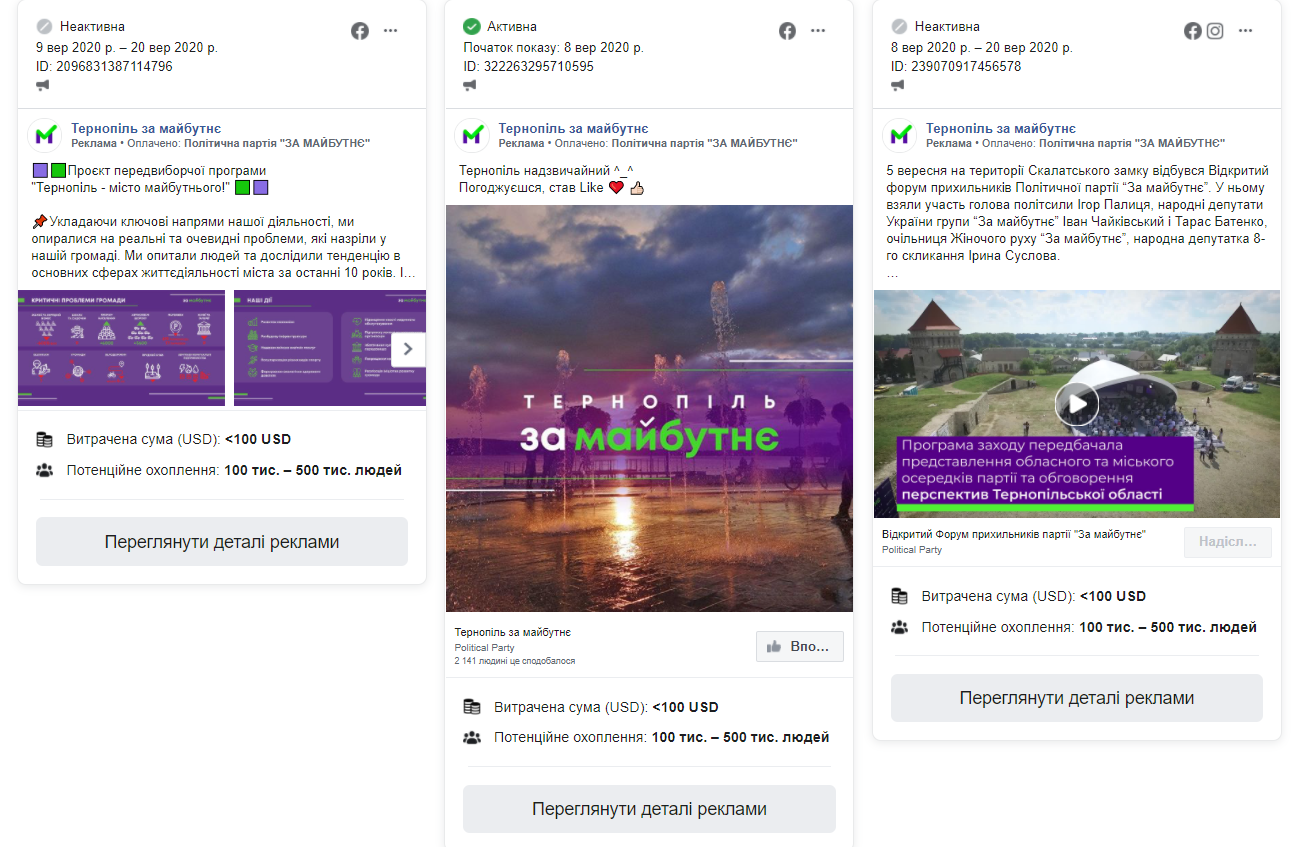
Second biggest spender for social media ads is the “Servant of the People”. In 15 days, the party spent over USD 36,000 for 1,424 posts. It is almost the same as the “Servant of the People” spent for advertising over the entire summer (USD 39,000). The party advertising promotion engaged 20 pages: central page of the Слуга Народу [lit. – Servant of the People], and regional pages Слуга Народу — Запоріжжя [Servant of the People - Zaporizhzhia], Слуга Народу. Тернопільщина [lit. – Servant of the People. Ternopil Region], a.o. They mostly advertised the posts about the “Big Construction” project, presented regional development strategies, and introduced candidates for local councils. There were also some posts inviting to join the local primaries. Actually, sometimes they had spelling mistakes [lit. – Do you wOnt change?]:
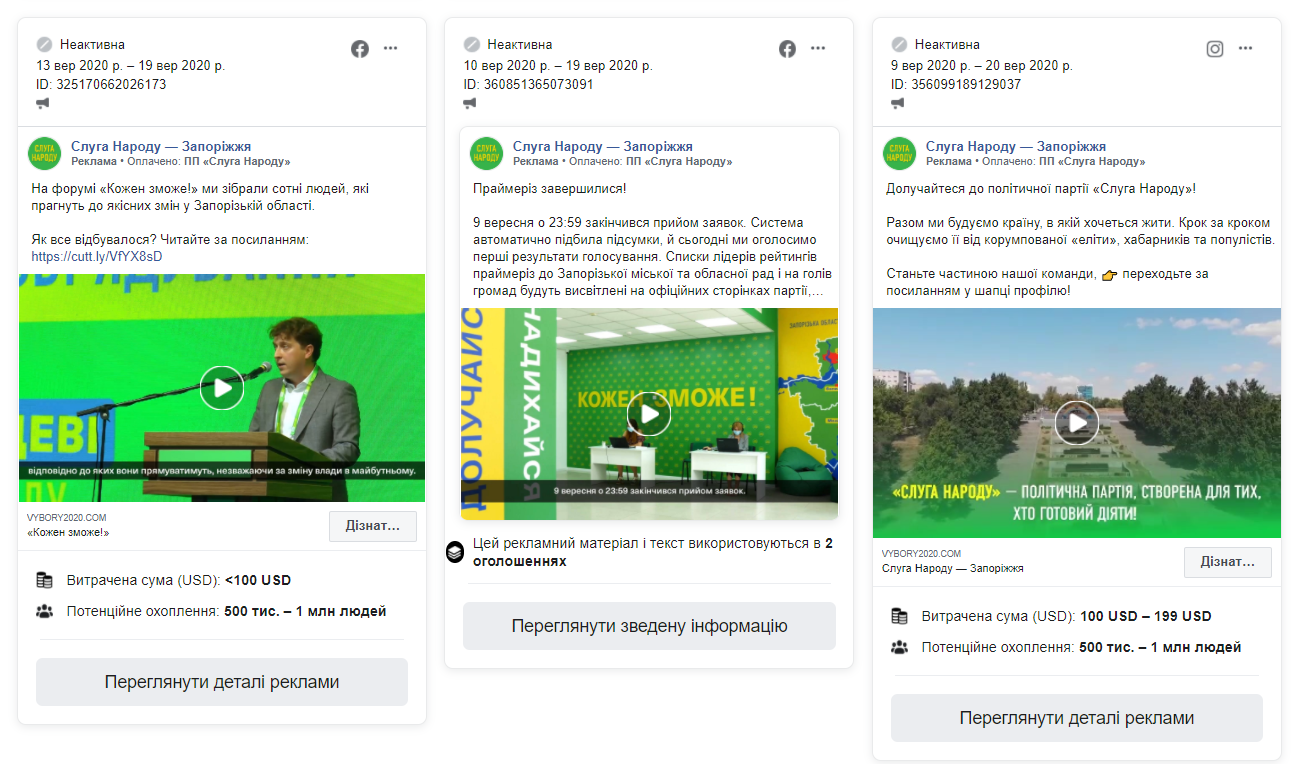
Targeting of the “Servant of the People” is not non-uniform. Ternopil Oblast accounted for 8.5% of ad views, Zaporizhzhia Oblast — 7.1%, Luhansk and Donetsk Oblasts Луганську, on the part of free territories not to have the elections eventually, the share is under 1%. The audience targeted with the ads from the “Servant of the People” is rather young: 63% are under 45 years of age.
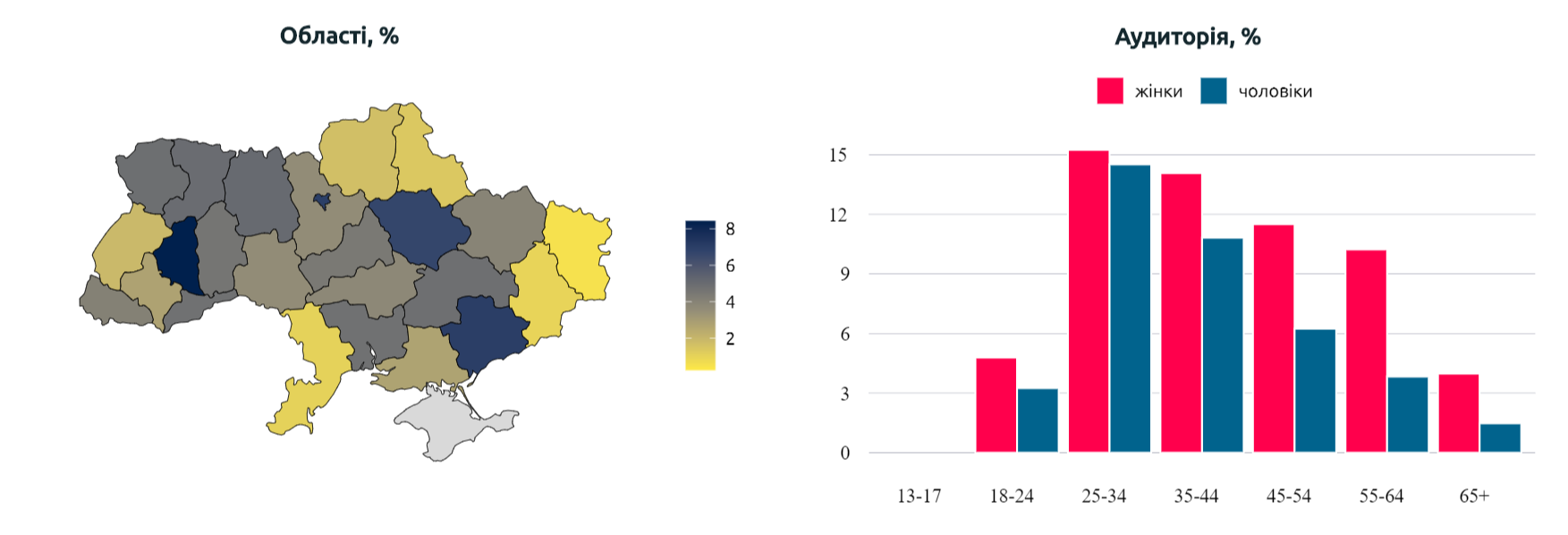
fb.oporaua.org
During the first two weeks of September, the “Palchevskyi Victory” got more active. In summer, the party spent for advertising as little as USD 12,000, but in a fortnight, they put out USD 15,000 (UAH 418,000). The money was spent for 163 posts promoted by three pages: Перемога Пальчевського [lit. – Palchevskyi Victory], Перемога Пальчевського - Білогородська ОТГ [lit. - Palchevskyi Victory – Bilohorodka hromada], and Перемога Пальчевського Рівне [lit. - Palchevskyi Victory. Rivne]. The posts were paid for by the “Palchevskyi Victory” NGO, but not the political party.
The targeting is indicative: 63.5% of posts addressed citizens of Kyiv, 8.1% — Rivne Oblast, 8.6% — Odesa Oblast. The target audience included mostly people of middle or older age — 75% over 35 years of age.
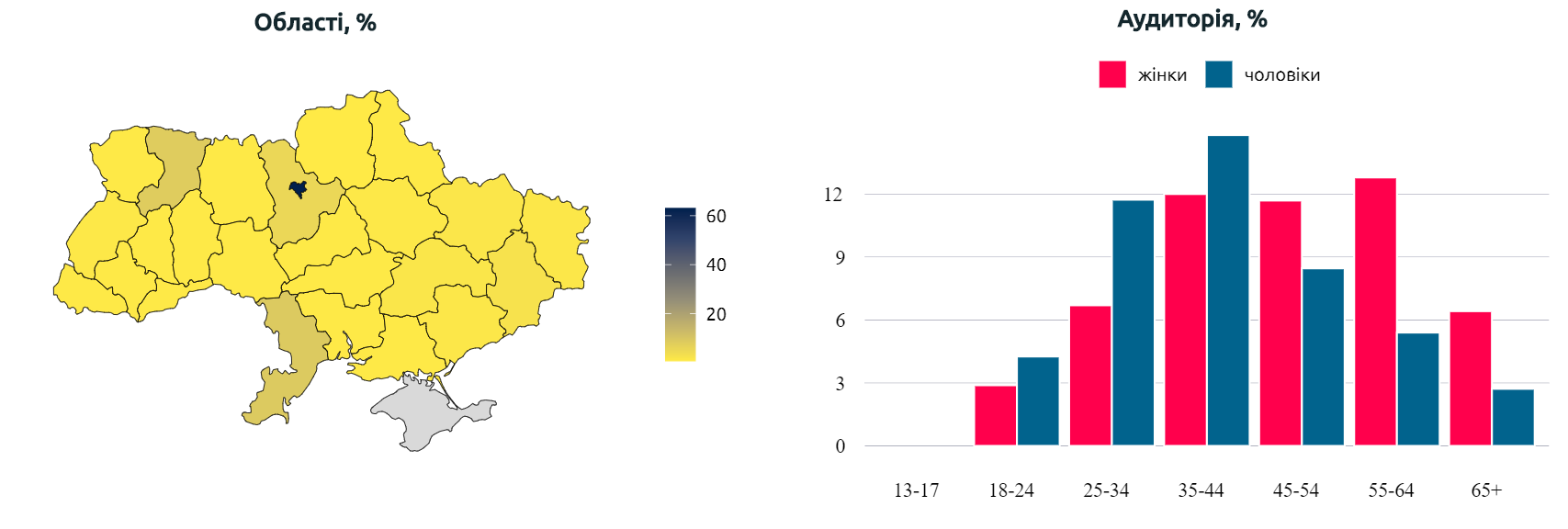
fb.oporaua.org
Most ads from the “ Palchevskyi Victory” included videos with the party leader Andriy Palchevskyi. In addition, many of them covered the opening of the new party reception offices. Some also include calls to “share about the problem in a hromada” (however, the party never promises to resolve it):

The page of Перемога Пальчевського [lit. – Palchevskyi Victory] published the most expensive post over the recent two weeks — Facebook estimates its cost for USD 3-3.5 thousand (UAH 85-99,000):
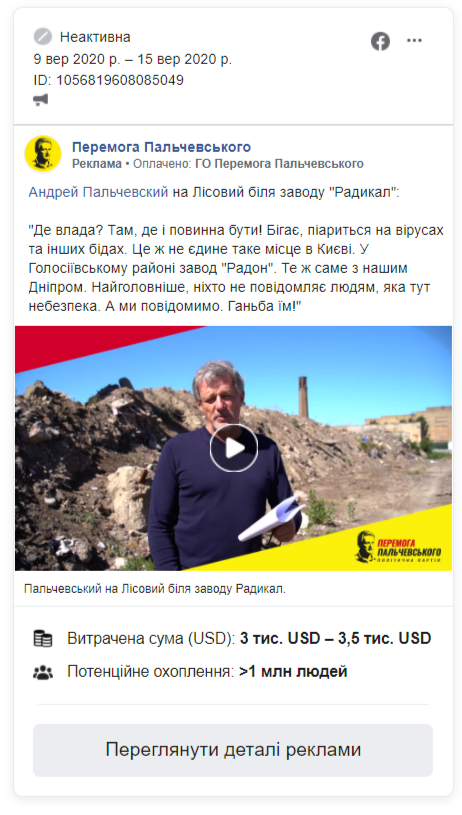
The following biggest spender is the “Proposition” party. In two weeks alone, they published 606 ads worth USD 11.7 (UAH 330,000). To compare: over the summer, the party pent UD 14,500. Advertising posts were published in 15 pages — on the main page of the Пропозиція [lit. - Proposition], and in several local pages, such as ПроМарганець [lit. - ProMarhanets] or ПроП’ятихатки [lit. - ProPyatykhatky]. For the most part, they introduced potential candidates to voters, invited to follow the party pages, etc. Such posts mostly mentioned the party leader, Dnipro city mayor Borys Filatov:

A separate category of the “Proposition” posts encouraged not to trust Volodymyr Zelensky and the candidates from the “Servant of the People”:
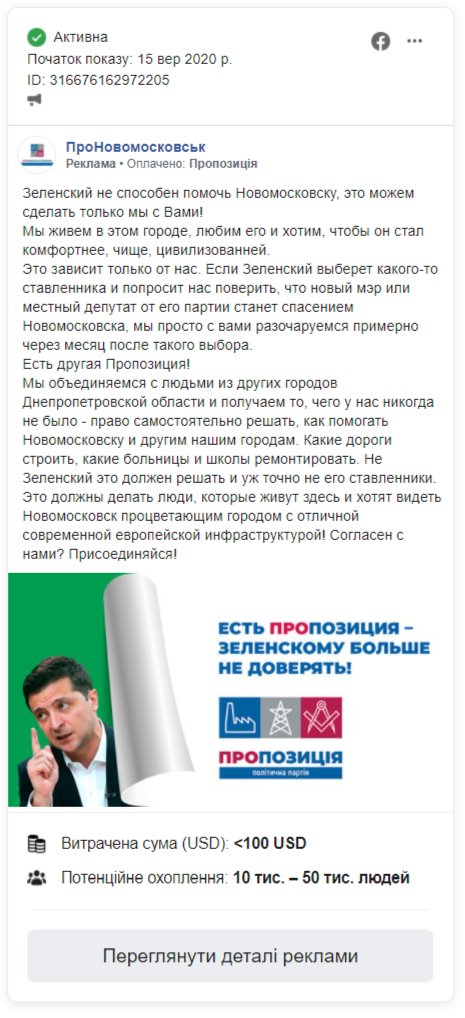
Most ads from the “Proposition” targeted Zhytomyr Oblast (38.2%) and Dnipropetrovsk Oblast (18.5%). Thereat, there was only one page targeting Zhytomyr region — Пропозиція Житомирщина [lit. – Proposition Zhytomyr region]. It spent much more money than other regional pages.
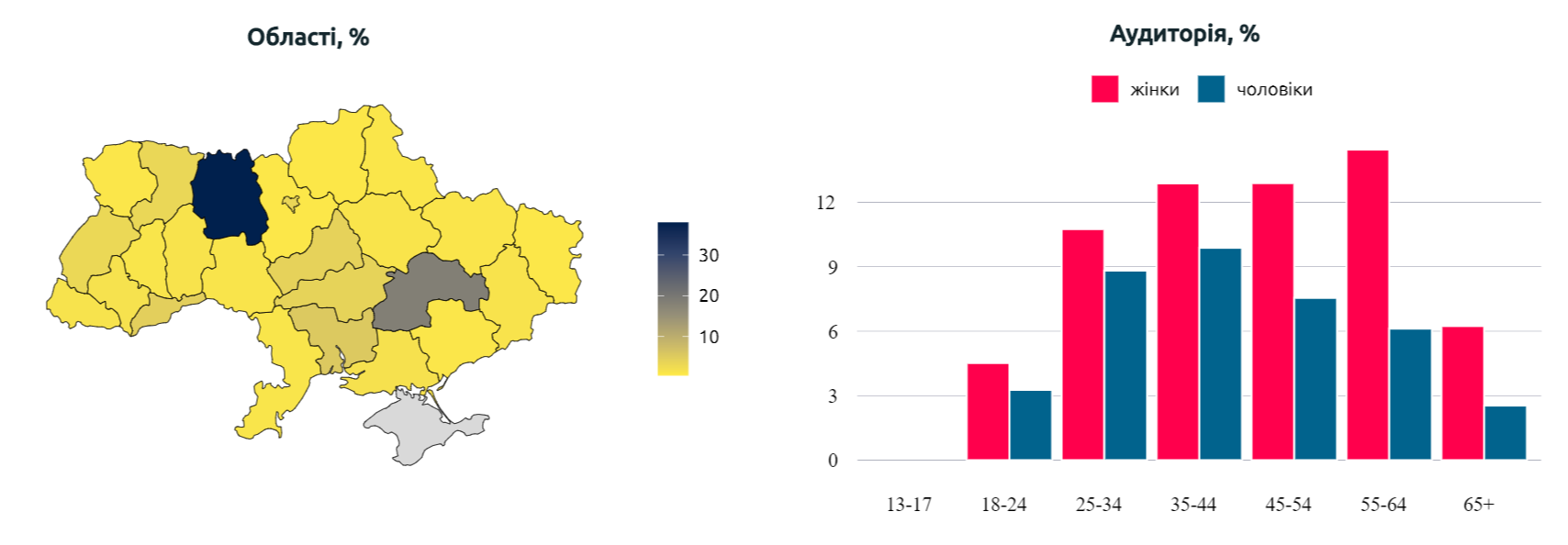
fb.oporaua.org
In the two weeks, “European Solidarity” spent USD 11.6 (UAH 327,000) — less than in the summer (almost USD 20,000). The party posted 146 ads on 13 party pages: on the central page of Європейська Солідарність [lit. – European Solidarity], and on the regional pages of Європейська Солідарність Закарпаття [lit. - European Solidarity. Transcarpathia], Європейська Солідарність Ірпінська ОТГ [lit. - European Solidarity. Irpin hromada], a.o. Most posts invited to join the party, follow its Facebook page, introduced local candidates and told stories about party activities in various places.
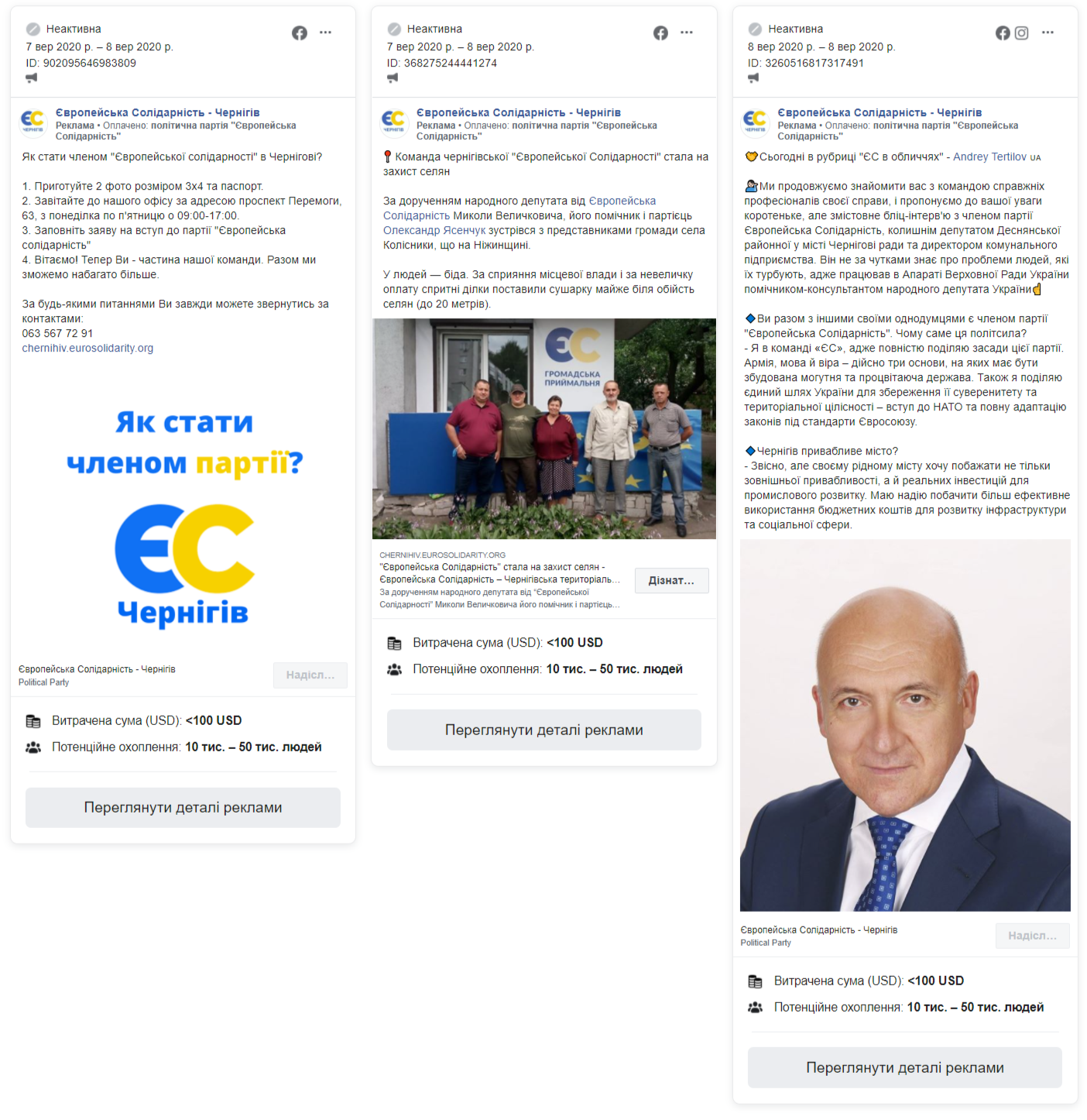
“European Solidarity” also promoted posts criticizing current government:

The “ES” ads targeted mostly western regions (Ternopil Oblast — 16.5%) and Kyiv (61.5%). The big share for Kyiv was provided by the activity of the page Європейська Солідарність — Київ [lit. - European Solidarity – Kyiv] that pent much money on Facebook ads. The audience targeted by the party was mostly middle-age (64% of readers are within 35-54 years).
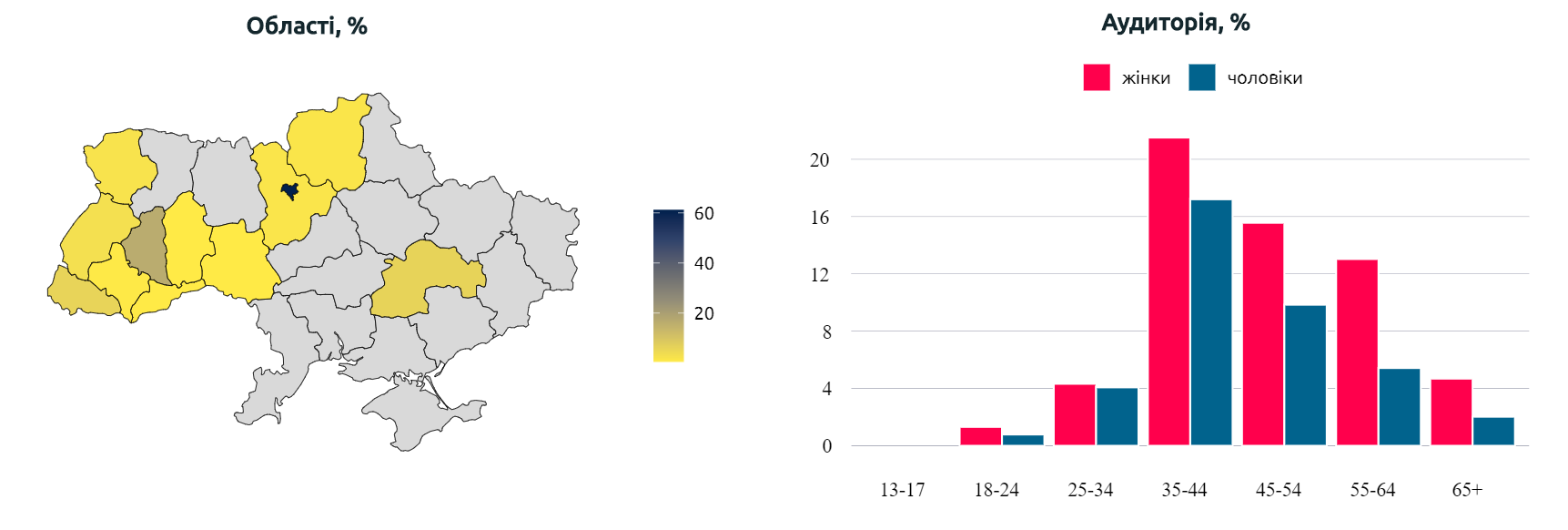
fb.oporaua.org
The “Nash Kray” party spent USD 10,700 (almost UAH 300,000) and ordered the largest number of ads worth the amount — 1,443 posts. They were promoted from five key pages: НАШ КРАЙ [lit. - NASH KRAY], НАШ КРАЙ Мена [lit. - NASH KRAY Mena], НАШ КРАЙ Ніжин [lit. - NASH KRAY Nizhyn], НАШ КРАЙ Славянск [lit. - NASH KRAY Slaviansk], and НАШ КРАЙ Сумщина [lit. - NASH KRAY Sumy region]). Most ads did not have any significant content:
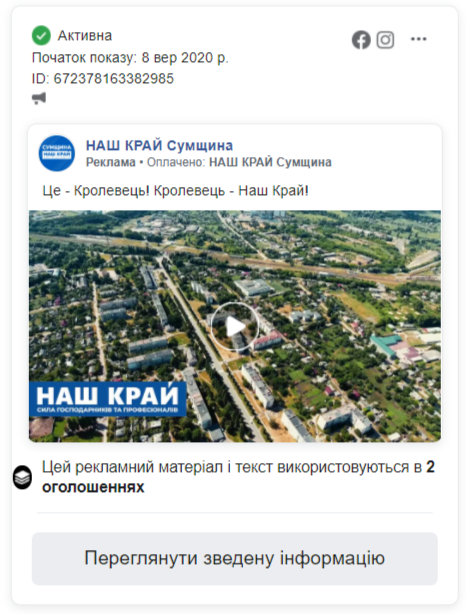
However, there were some posts that introduced party candidates to voters, the party’s slogan, and shared party agenda:

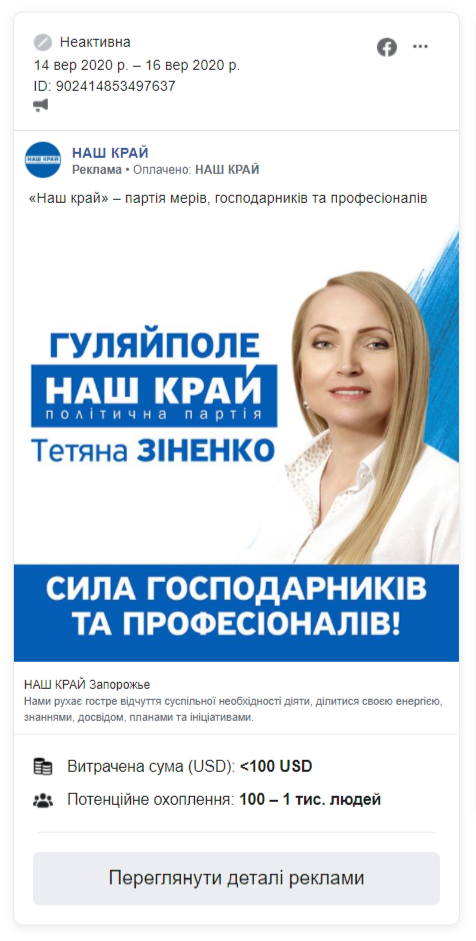
The party laid a special focus on Sumy Oblast (9.7%), Dnipropetrovsk Oblast (7.9%), and Odesa Oblast (7.4%). However, advertisements were promoted to all regions. The audience offered to view the ads hardly included any young people under 35, and 65% were women over 35.

fb.oporaua.org
“UDAR of Vitaliy Klitchko” did not get into the summer top-10, but in the last two weeks they started spending on advertising much more than before, and got to the sixth position in the ranking of the first half of September. Party costs on Facebook ads amounted to USD 6,711 (UAH 188,000). They covered 195 ads on four pages: УДАР Віталія Кличка [lit. – UDAR of Vitaliy Klitchko], Партія УДАР Віталія Кличка. Дарницький район [lit. – UDAR of Vitaliy Klitchko. Darnytsia district], Партія УДАР Віталія Кличка. Дніпровський район [lit. – UDAR of Vitaliy Klitchko.Dnipro district], and Партія УДАР Віталія Кличка. Святошинський район [lit. – UDAR of Vitaliy Klitchko. Sviatoshyno district]. The posts mostly described Vitaliy Klitchko and party achievements. Rather many posts were about the party convention.
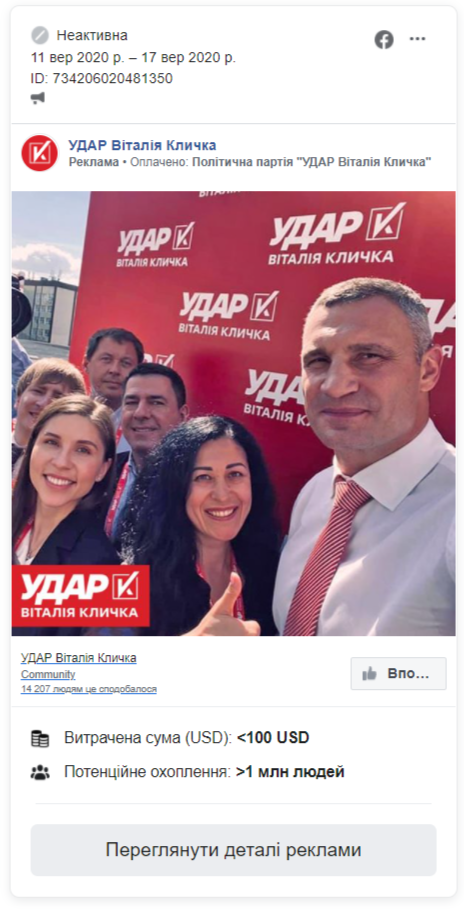

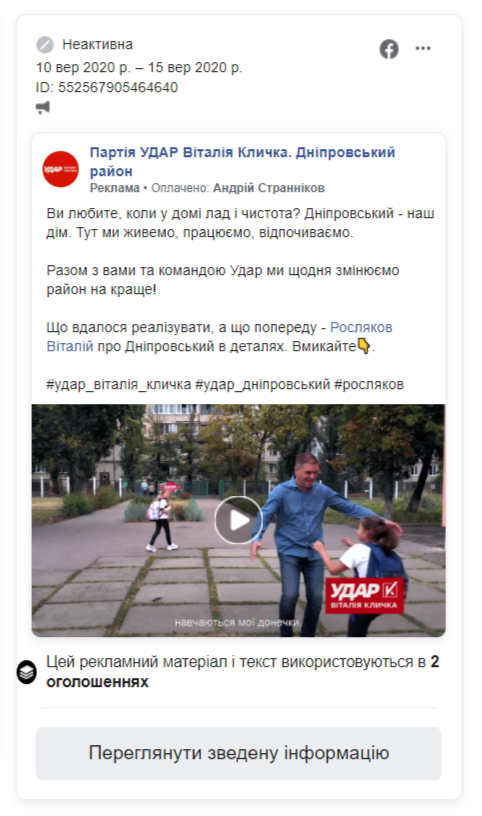
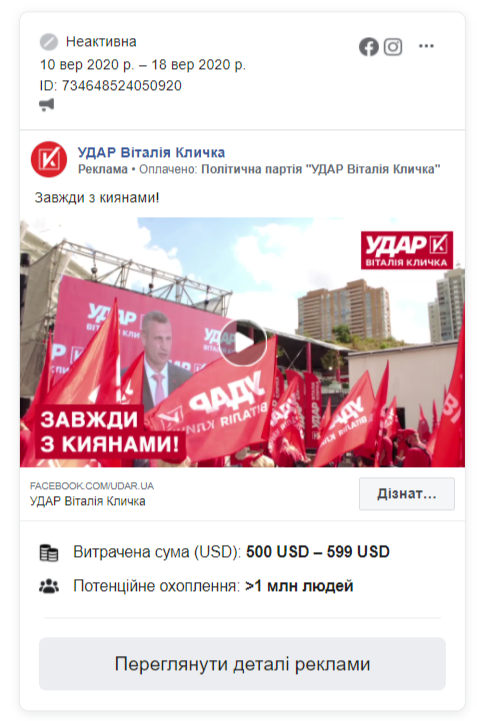
“Opposition Platform — For Life” spent in two weeks USD 6,300 (UAH 178,000) for 243 advertising posts published by the pages Дніпровська міська організація ПП «Опозиційна платформа — За життя» [lit. – Dnipro City Organization of the “Opposition Platform – For Life” PP], Опозиційна Платформа — За Життя у Київській Області [lit. - “Opposition Platform – For Life” in Kyiv Oblast], and Офіційна сторінка Тернопільська "Опозиційна платформа — За Життя" [lit. – Official page for Ternopil branch of the “Opposition Platform – For Life” PP]. Thus, most posts targeted Dnipropetrovsk Oblast (88.9%), Kyiv city and Kyiv Oblast (7.6%), and Ternopil Oblast (1.6%). 66% of the audience were women.

fb.oporaua.org
They mostly advertised the posts about the work of candidates from the OPFL to local councils or for city heads, and also posts criticizing central government:
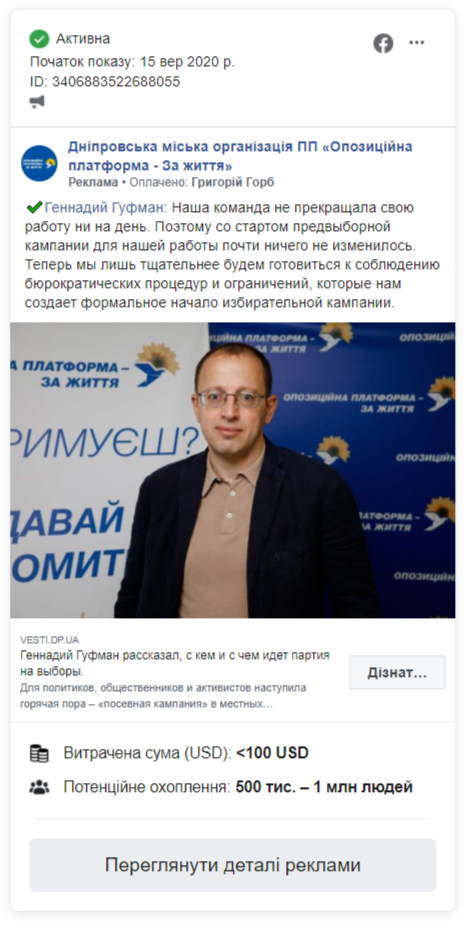
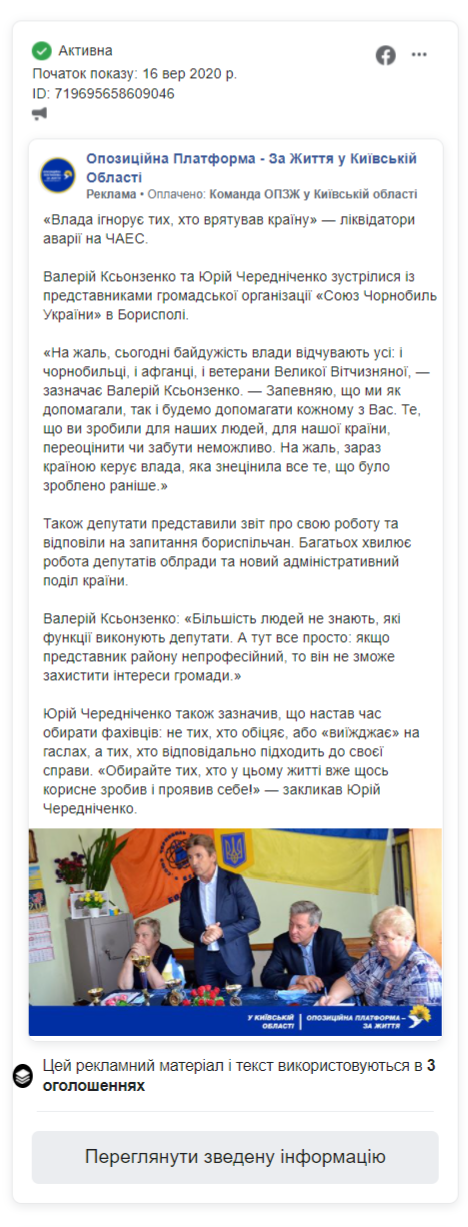
A new member of the top-10 is the “Bereza EcoParty”. In summer, they did not launch any advertising but in the first weeks of September they spent almost USD 6,000 for 164 posts on the page of the ЕкоПартія Берези [lit. – Bereza EcoParty]. Mot posts criticized Kyiv city authorities and promised to tackle city problems. The party kept reiterating that their leader Boryslav Bereza was a Kyivite:

“Bereza EcoParty” is the only party on the top list that target their ads mostly at men (55.6% of the audience) and at Kyiv only.
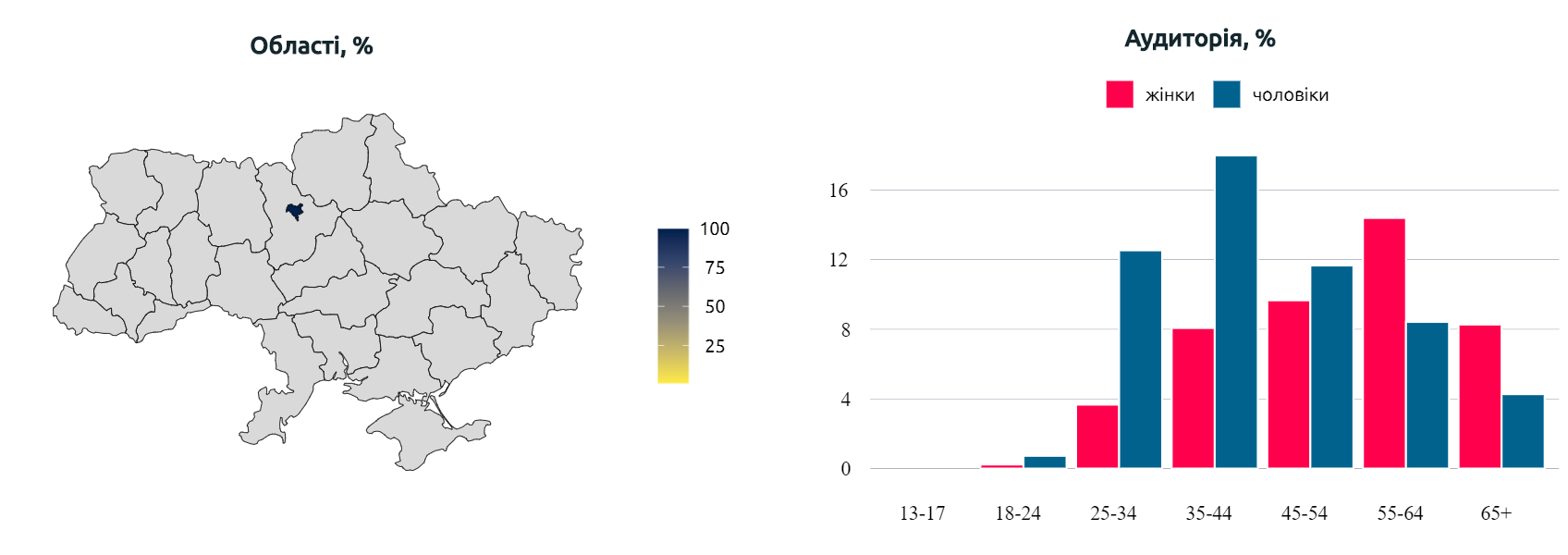
fb.oporaua.org
One more local actor in the top-10 is the “Udovichenko Team – Ridne Misto”. From June to January, they spent USD 3,900 on Facebook ads. In the first two weeks of September, they invested into promotion in social media nearly as much: 3,200. The party used the money to promote 123 ads on the page of Команда Удовіченка - Рідне місто [lit. - Udovichenko Team – Ridne Misto]. It is interesting that the party was the only one to pay for the ads in Russian roubles.
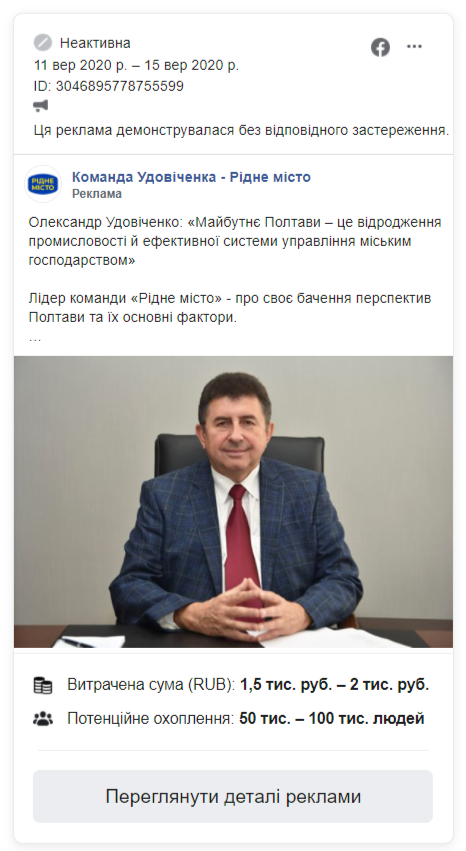
99% of ads of the “Udovichenko Team” target Poltava Oblast.
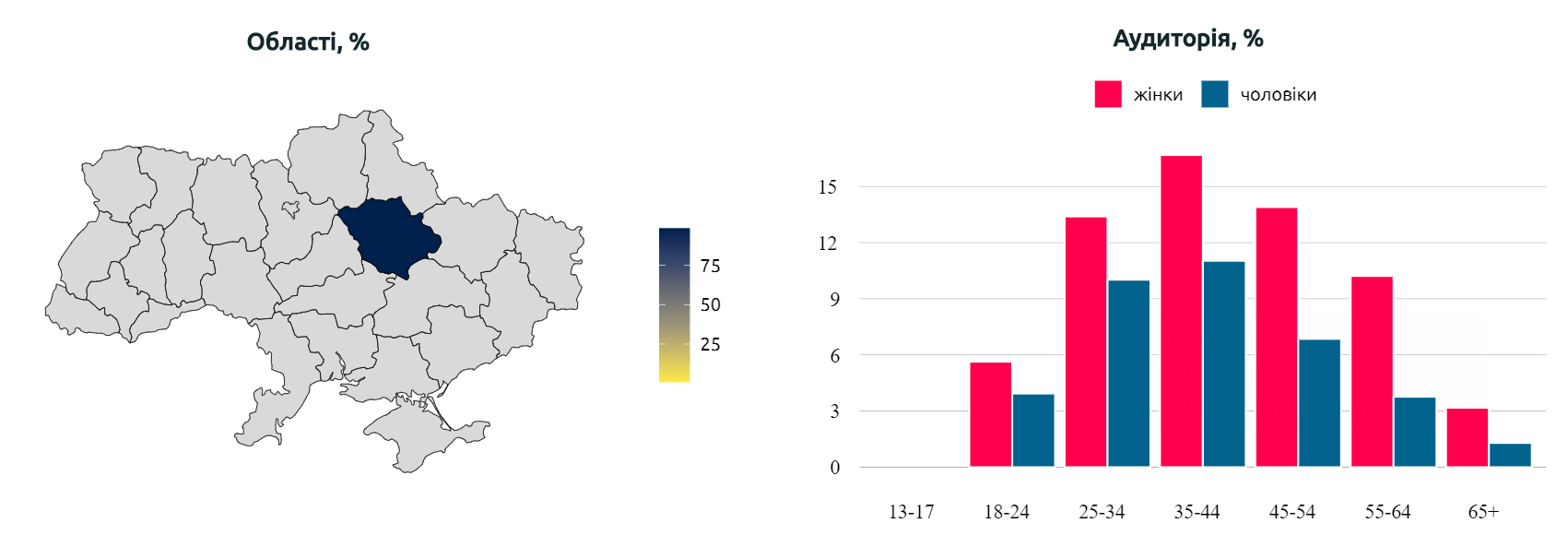
fb.oporaua.org
The posts mostly report on party activities.
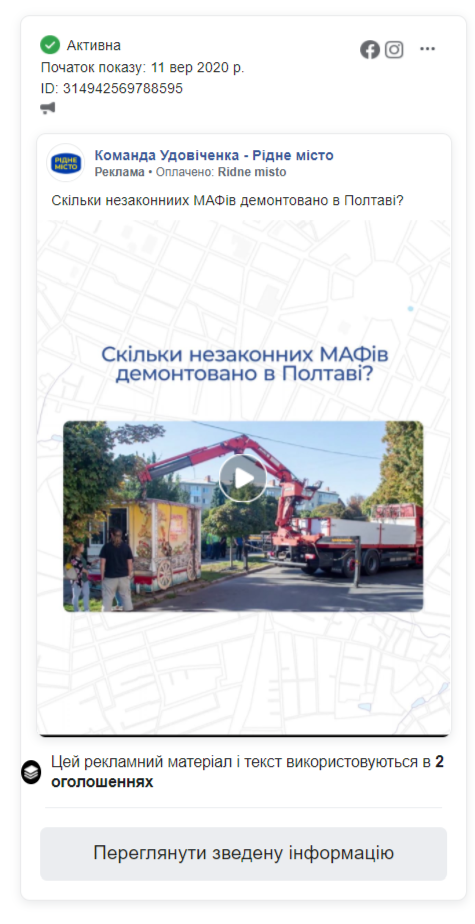
With the approach of elections, social media received more ads ordered by individual candidates (officially registered electoral participants or those intending to run for elections) for deputies of heads. In total, they spent USD 46,000 for 2,652 promo posts. Geographical distribution of the advertisements is rather non-uniform. Specifically, Volyn, Chernihiv, Kirovohrad, Kharkiv, Kherson, Donetsk, and Luhansk Oblasts only were targeted by under 0.1% of posts. In terms of amounts spent, Kyiv and Lviv are in the lead.
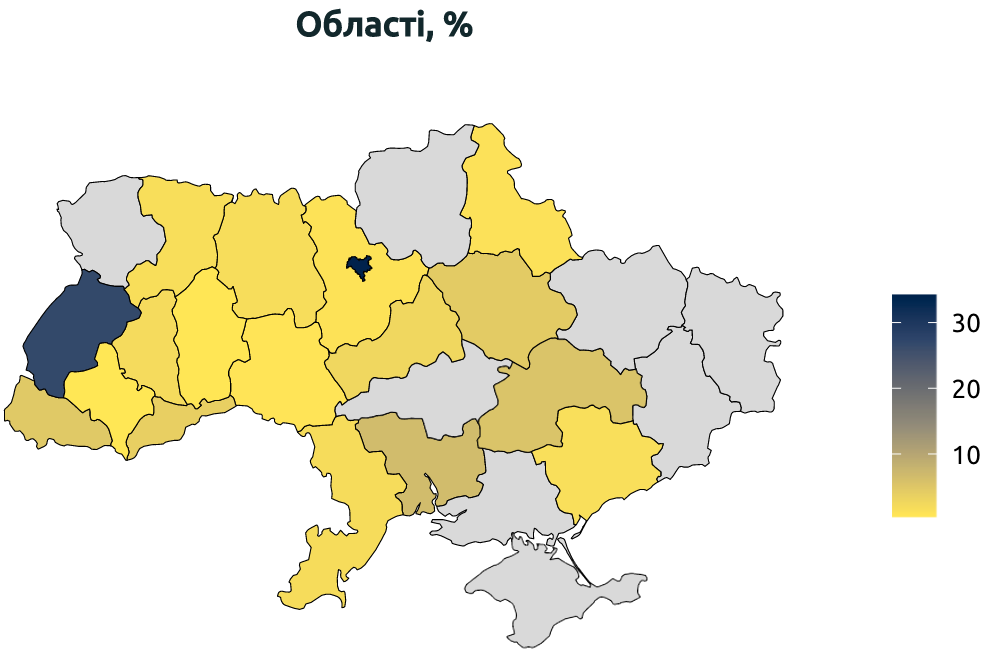
fb.oporaua.org
To be more precise, the highest amounts were spent for promotion by candidates for the Kyiv city mayor Iryna Vereshchuk and Vitaliy Klitchko, for Lviv — Andriy Sadovyi and Ihor Vasiunyk, and Poltava mayoral candidate Andriy Matkovskyi.
|
Candidate |
Costs |
Number of ads |
|
Iryna Vereshchuk |
20,945 |
1,794 |
|
Vitaliy Klitchko |
5,030 |
32 |
|
Andriy Sadovyi |
2,460 |
15 |
|
Ihor Vasiunyk |
2,144 |
26 |
|
Andriy Matkovskyi |
1,490 |
66 |
|
Yaroslav Rushchyshyn |
1,475 |
77 |
|
Oleksiy Kucherenko |
1,228 |
12 |
|
Sergey Kalynchuk – Odesa mayor 2020 |
1,368 |
71 |
|
Vitaliy Druhanovskyi |
987 |
28 |
|
Serhiy Ryzhenko |
751 |
39 |
Iryna Vereshchuk running for the position of the city mayor from the “Servant of the People” spent over USD 20,000 for 1,656 ads — more than the following four candidates from the ranking in total.
Half ads for Vereshchuk targeted the audience from 25 to 44 years of age, gender-balanced; in the category 45+, 24.2% of ads target women (of the 38.2% of the total targeting for this age group):

fb.oporaua.org
In most posts, Vereshchuk is telling about herself, draws attention to her article (e.g., in her slogans “A Woman to be the Next Mayor,” “Madam Mayor” and “A Woman Can Do More”), criticizes her rival Vitaliy Klitchko, and presents her plans in case she wins in the elections:

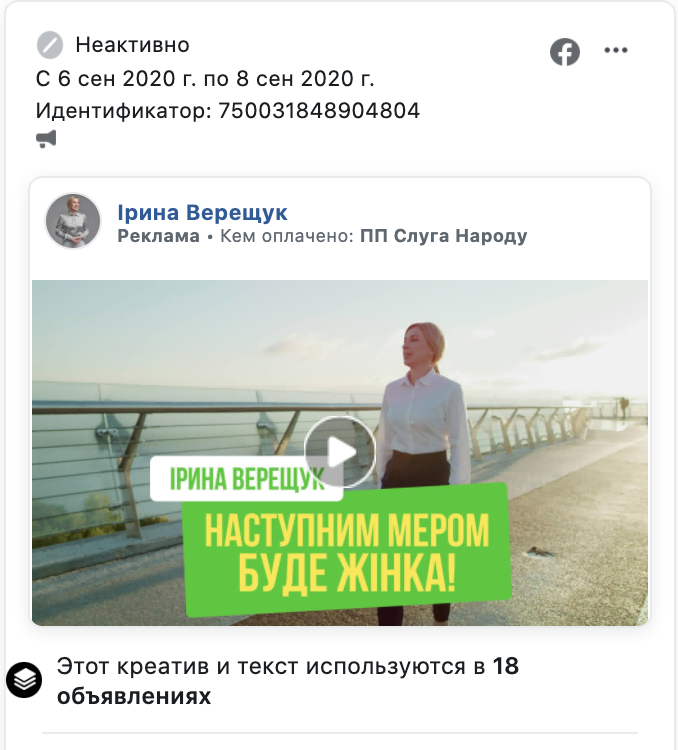

Vitaliy Klitchko was the second biggest spender for political ads: almost USD 4,000 for 31 ads. Klitchko’s target audience was slightly younger than Vereshchuk’s – 47.3% post of Klitchko targeted people aged 18 to 34:

джерело: fb.oporaua.org
All ads on the Klitchko’s page promote a slogan “Always With the Kyivans!”:
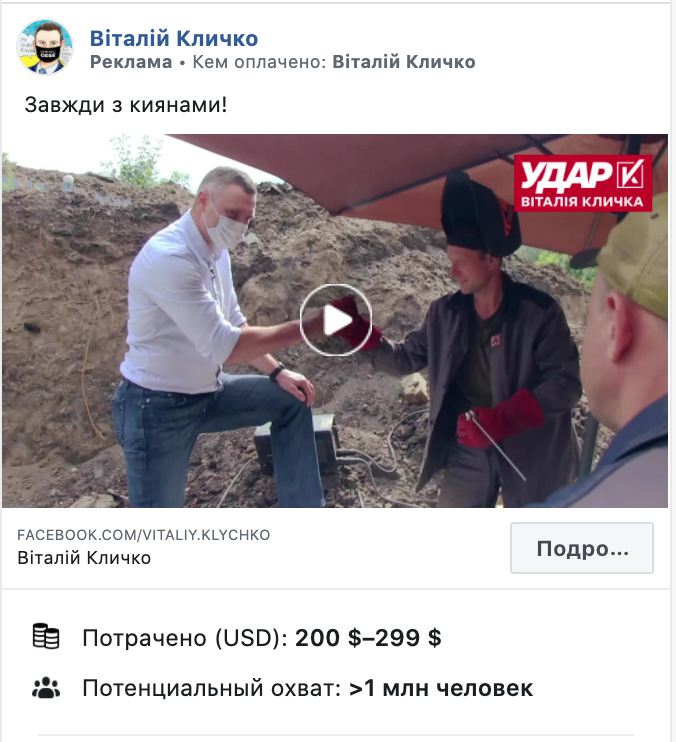
Position three and four are taken by mayoral candidates for Lviv – Andriy Sadovyi and Ihor Vasiunyk. Sadovyi spent UD 2,460 for 15 promo posts. Sadovyi’s ads mostly target middle-age people and young people:

fb.oporaua.org
The incumbent Lviv city mayor Andriy Sadovyi aspires for the fourth term. In his advertising posts, he is telling about the achievements of his team and the priorities for the future work, in the event he wins:
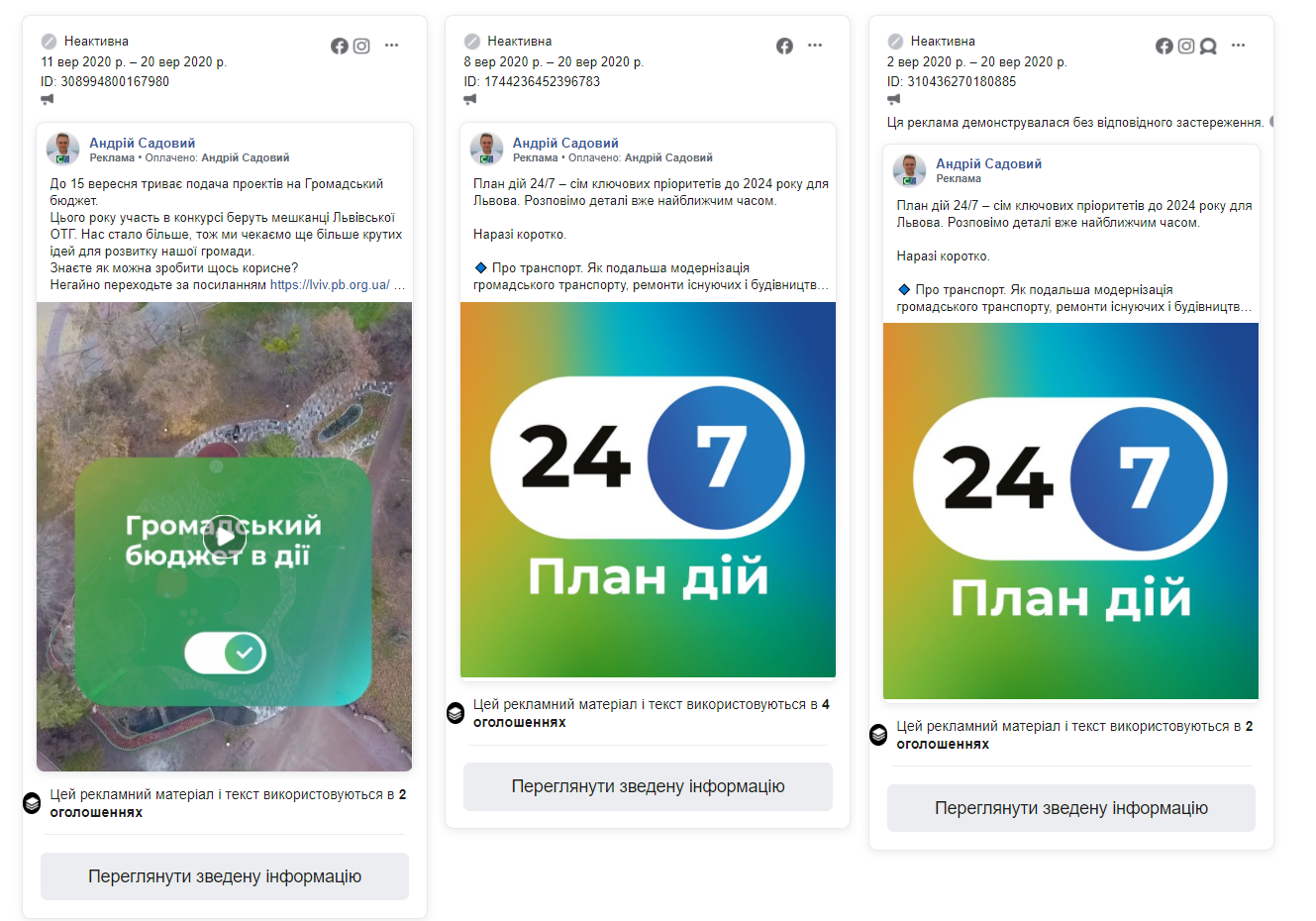
The incumbent Lviv city mayor Andriy Sadovyi aspires for the fourth term. In his advertising posts, he is telling about the achievements of his team and the priorities for the future work, in the event he wins:

fb.oporaua.org
In his ads, Vasiunyk promotes a slogan “Lviv is the First!” He tells stories about his plans in case he wins, and invites to come to events organized by his team:
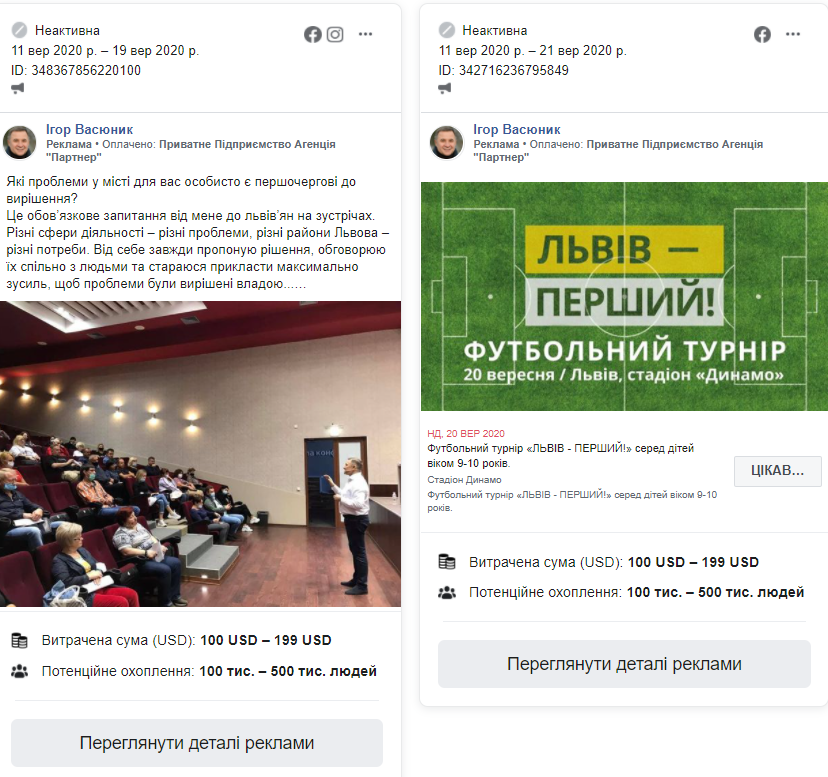
The candidate for the Poltava city mayor Andriy Matkovskyi spent USD 1,347 for 52 promo posts. His audience is much older than of other top candidates, and they are mostly women:

fb.oporaua.org
In his posts, Matkovskyi promises to repair the houses, to build skate parks and dog walking grounds, organizes book giveaways, encourages to honor your parents and respect the veterans:

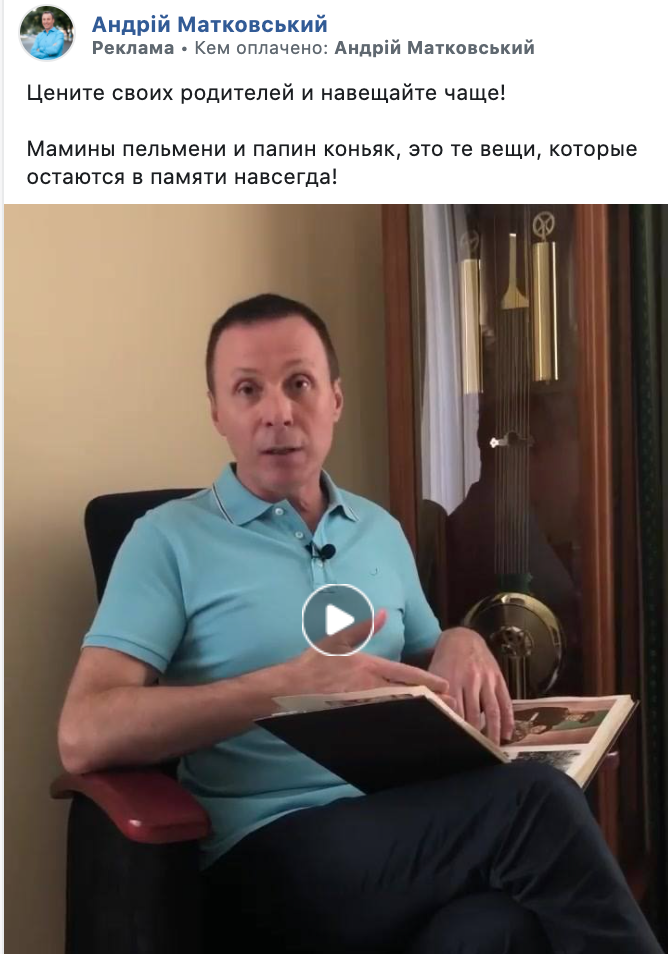
Over 2,500 ads campaign in favour or against certain political forces or candidates, and they were published by pages not owned by electoral participants. The political ads from the pages of politicians, local and national mass media, and “interest” pages (i.g. fan pages supporting certain candidates, pages for citizens of certain cities, and even the new moms pages) spent the total of USD 90,000 (over UAH 2.5 mln). 50,000 was spent on ads from the politicians’ pages, over 15,000 — from the mass media pages, over 25,000 — for ads from the “interest” pages. In terms of amounts spent, the top spender is the Ihor Palytsia, leader of the party “For the Future”, members of the same party Oleksandr Shevchenko and Yaroslav Moskalenko, an online media “Litsa” and “Priama Mova”.
|
Page |
Costs |
Number of ads |
|
Ihor Palytsia |
17,203 |
237 |
|
Oleksandr Shevchenko |
12,935 |
185 |
|
Litsa media |
4,691 |
555 |
|
Priama Mova |
4,043 |
197 |
|
Yaroslav Moskalenko |
3,493 |
166 |
The biggest number of political ads from the mass media could be viewed by users from Dnipropetrovsk Oblast (54.03% views) and Odesa Oblast (17.67%), while users from Chernihiv and Chernivtsi Oblasts hardly ever saw such ads (under 0.1% of views):
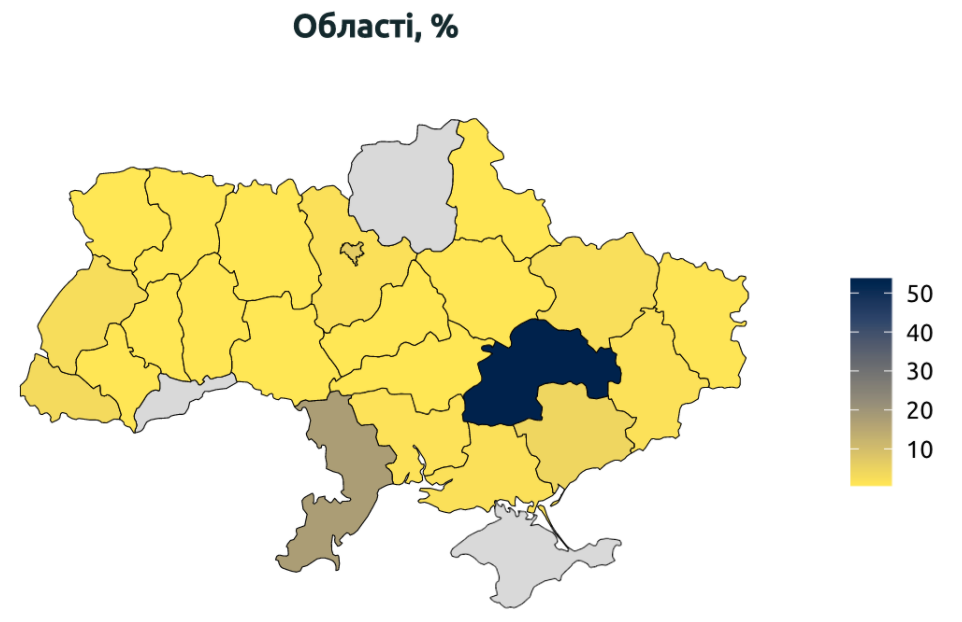
fb.oporaua.org
In most cases, political ads on the mass media pages mentioned Dnipro city mayor Borys Filatov and his fellow teammate Hennadiy Korban (“Proposition” party). The ads went out on the pages of seven local media. They were not only the positive materials. For instance, the “Dnipro Backstage” promoted materials criticizing Filatov, Korban, and the “Proposition.”


There is a similar case on the page of the media “Dnipro accent” and “Litsa”:

On the other hand, “Our City”, “Dnipro TV”, “Dnipro Panorama” and others promoted posts in support for Filatov:
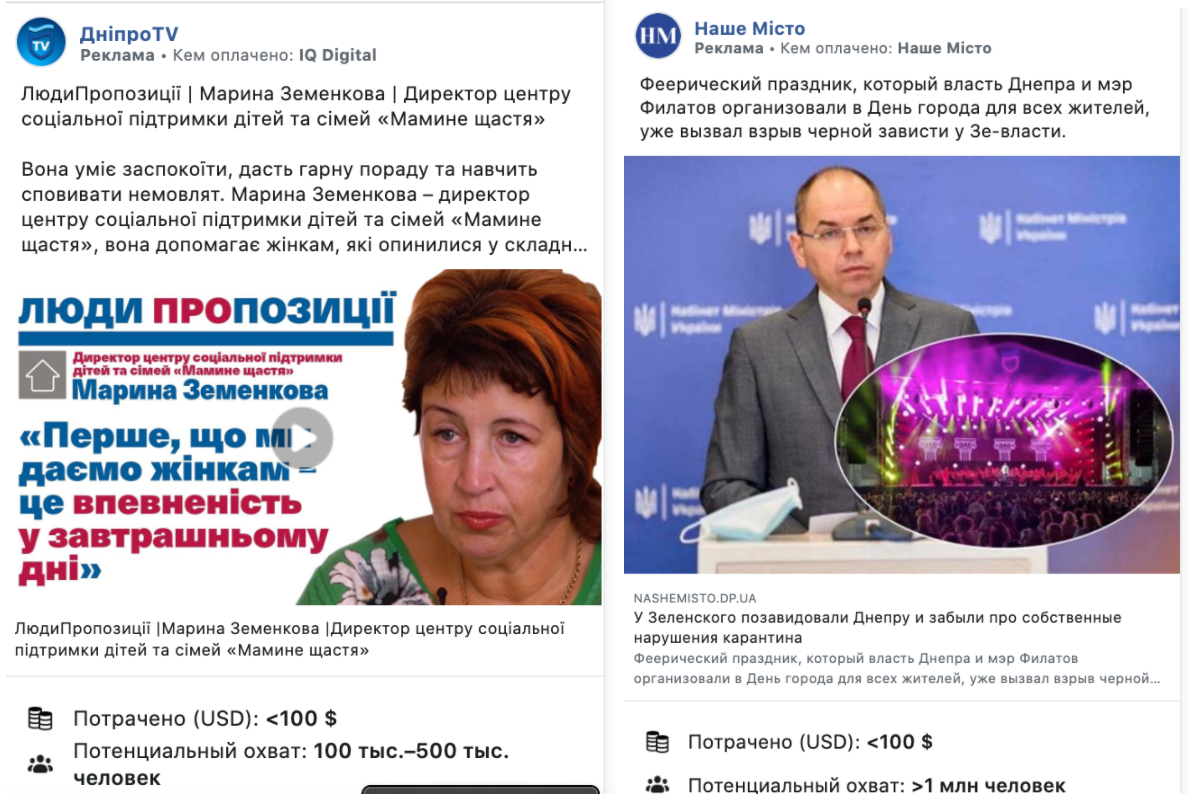
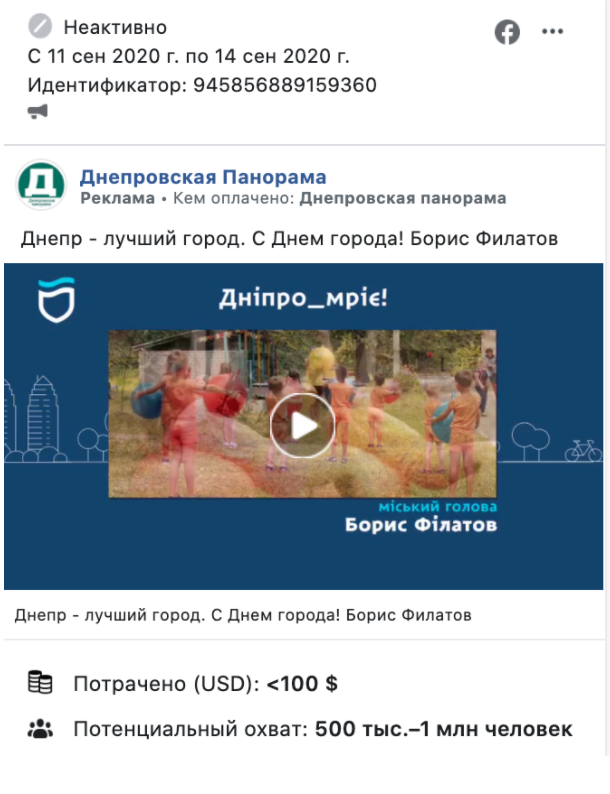
The “interest group” pages most often include pages created to support or discredit certain candidates or political forces: “Fellow Countrymen for Zelensky,” “Uzhgorod without Andriyiv,” “I Vote for Svitlychna,” “Kryvyi Rih for Yuzik,” and suchlike.
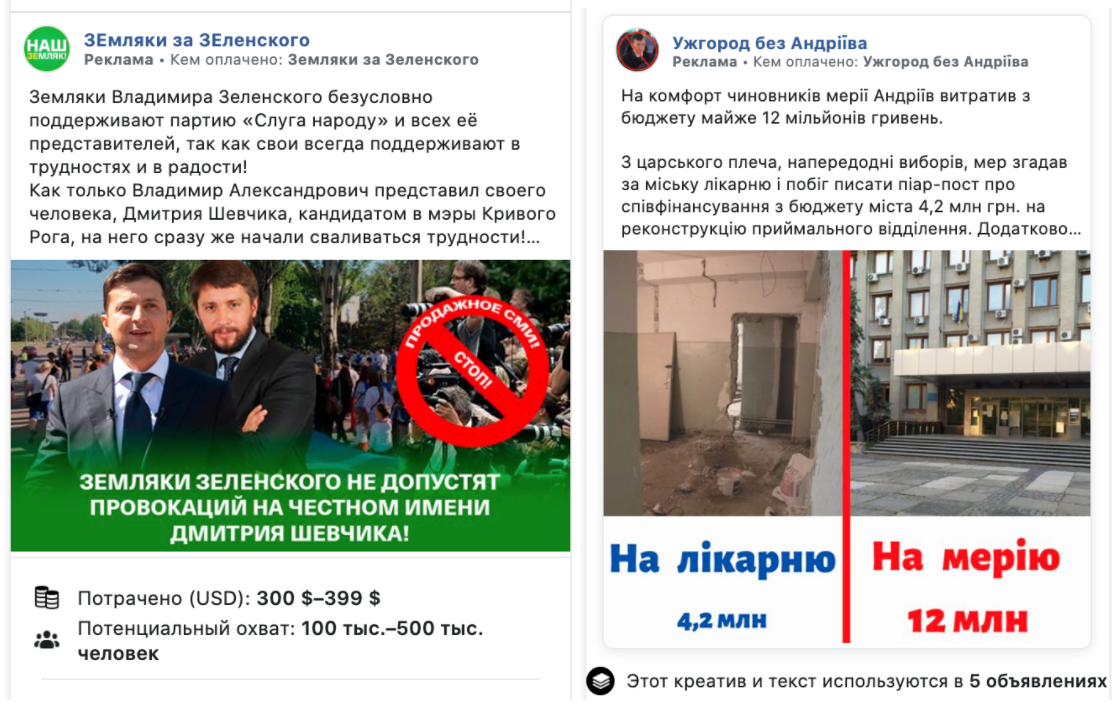
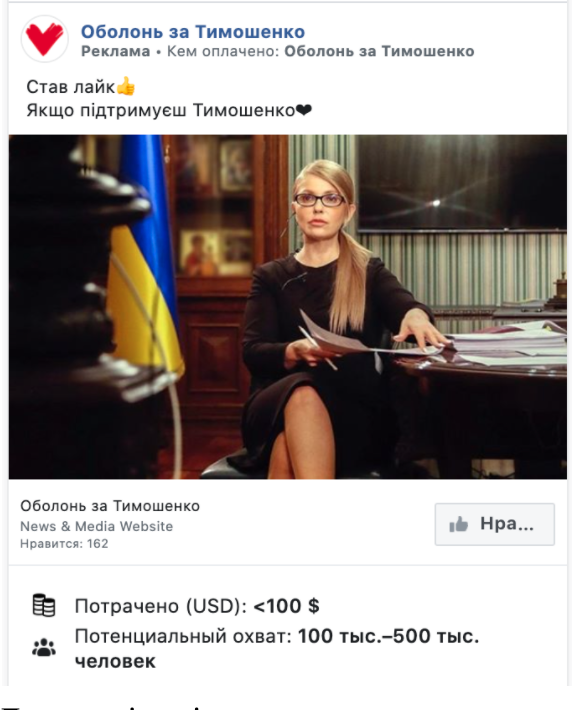
Posts supporting or criticizing possible candidates and political forces can be come across on pages uniting residents of cities: “Typical Kryvyi Rih,” “I am the Dnipro,” “Energy of Lviv” etc.
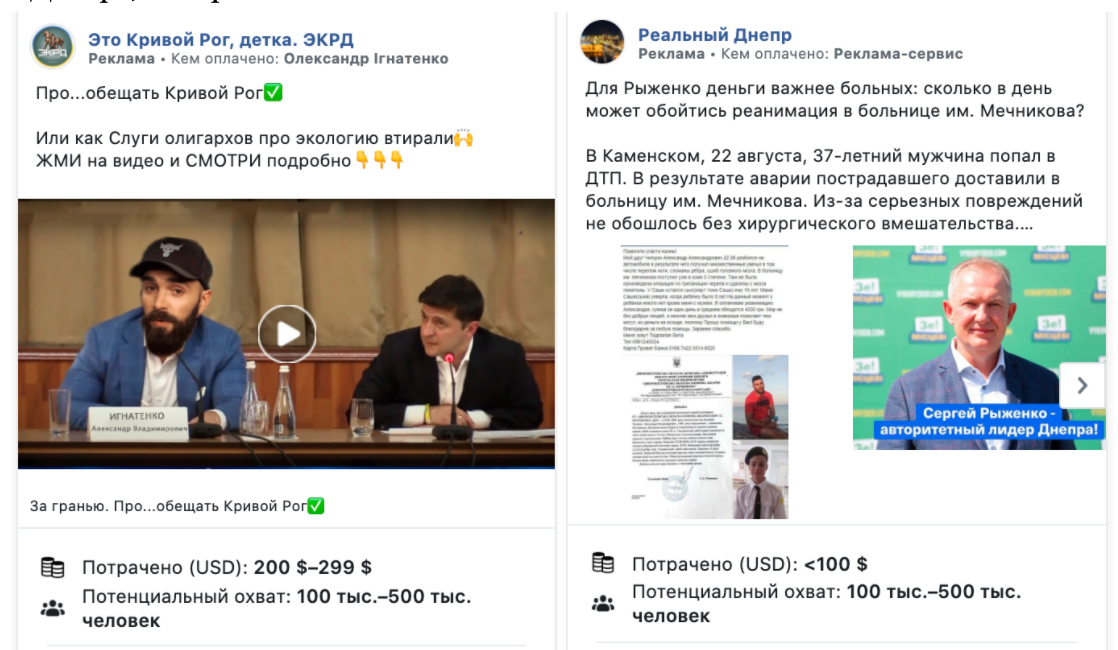
Political ads were even published on the pages of the “Best Telegram-channels” and in the “mom” community Mother’s Group:
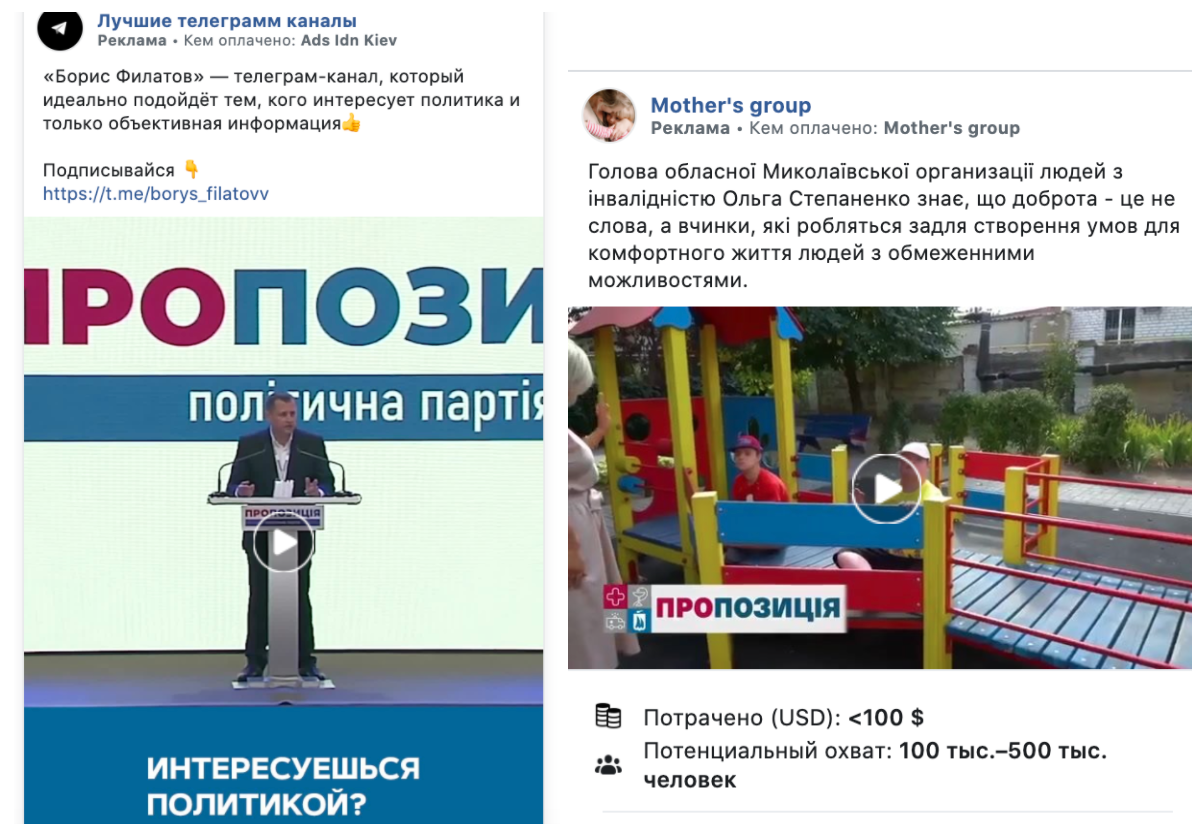
Under other circumstances, the ads could discredit further participation of a candidate or a party in elections, since electoral law only allows to pay for campaigning form the election funds… However, the acting Ukraine’s law does not cover the social media. “The new electoral code totally failed to resolve an issue of distinguishing between political advertising and pre-election campaigning, it does not regulate early campaigning issues, or political advertising on social media. Certain problematic issues have aggravated during elections,”— comments Olha Kotsiuruba, OPORA expert. Under the current law, any advertising administered by a potential candidate shall not be considered as campaigning before candidates are registered as electoral subjects. Moreover, local elections subjects are the regional party organizations. Therefore, if an ad in social media is published by the party central office, it would be literally impossible to establish the “right” subject.
Olha Kotsiuruba explains: according to the law, the duration of an election process is 50 days, while you are eligible to legally campaign only after the registration. Final decisions about the registration shall be made by September, 29. It implies that the time for lawful campaigning is cut to 24 days. Besides, the code does not include anything about restrictions for campaigning on the Internet.
“The entire range of issues cannot be possibly resolved by focusing on isolated challenges. We need to increase the duration of electoral process. The start of campaigning shall be linked to the moment of a party’s or a candidate’s decision, rather than to the registration moment. We also need to recognize parties as campaigning subjects in general, rather than its separate organizations. The concepts of political advertising and campaigning hall be distinguished. Advertising and campaigning in social media shall be regulated by the electoral law, and by the law on media, while an independent regulator shall control the abiding to the provisions — such as the National Council for Television and Radio,” says Olha Kotsiuruba. However, it is not clear when the changes to electoral law may be approved. At the same time, the 2020 local elections are going to run under the acting electoral code. OPORA will continue to keep track of the ads from political parties and candidates in social media, and notify who pays how much and for what.
